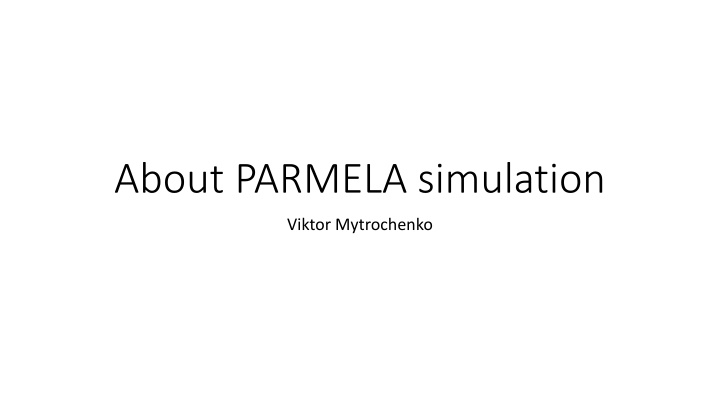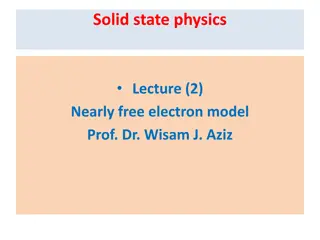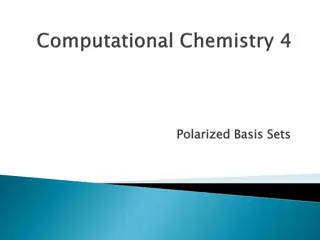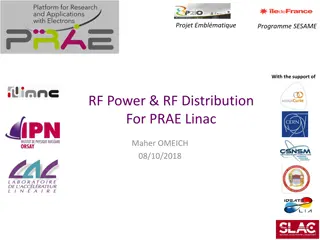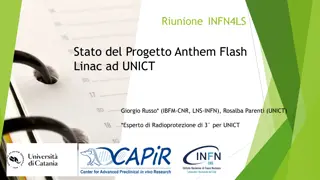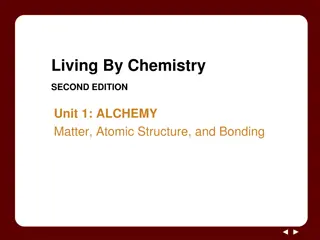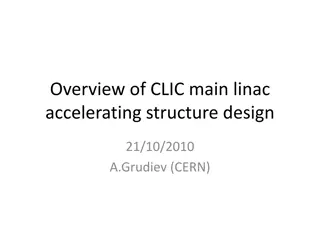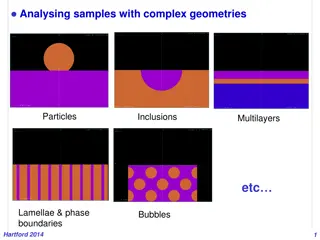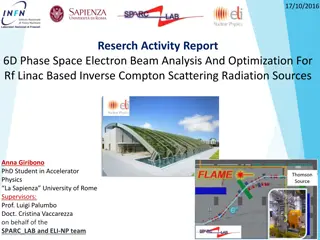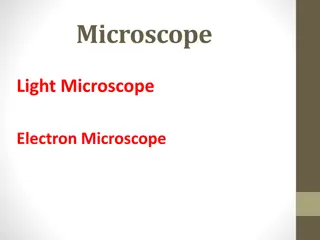Overview of PARMELA Simulation Code for Electron Linac Design
PARMELA is an electron linac design code used for macroparticle tracing. It is a flexible program with 40 keywords that define various elements and actions in the input data. The main program controls the logical flow, while the PARDYN subroutine manages particle dynamics calculations. Although access for code upgrading was denied after version V3.22, the program remains functional for designing linac systems.
Download Presentation

Please find below an Image/Link to download the presentation.
The content on the website is provided AS IS for your information and personal use only. It may not be sold, licensed, or shared on other websites without obtaining consent from the author.If you encounter any issues during the download, it is possible that the publisher has removed the file from their server.
You are allowed to download the files provided on this website for personal or commercial use, subject to the condition that they are used lawfully. All files are the property of their respective owners.
The content on the website is provided AS IS for your information and personal use only. It may not be sold, licensed, or shared on other websites without obtaining consent from the author.
E N D
Presentation Transcript
About PARMELA simulation Viktor Mytrochenko
What is the PARMELA code Parmela is an electron linac design code (macroparticle tracing code). We use the official Los Alamos Parmela code that was granted to us in middle of 90th. Last version that we upgraded was V3.22, then they denied access for code upgrading (may be in 2002). But nobody said that we could not use it. From a Parmela manual: Parmela was designed to be very flexible. Two portions of the code serve as the skeleton. The main program Parmela responds to the input data and controls the logical flow of the program, and the subroutine PARDYN controls the logic of the particle dynamics calculations. The input data define the transport system, specify the control logic, and specify the input and output options. Each line recognized by Parmela consists of a keyword followed by various parameters. The keyword determines the action taken by Parmela. The order of the keywords is unimportant except as noted. For example, the elements in the transport system must appear in the proper sequential order. Some keywords define beam-line elements, described by three or more parameters.
There are 40 keywords RUN, the first line in the Parmela input file TITLE, defines a title line CATHODE, a spherical cathode DRIFT, a drift space SOLENOID, a solenoid lens QUAD, a magnetic quadrupole lens BEND, a dipole magnet with bend in the x direction BUNCHER, for a buncher cavity CHOPPER, a beam chopper CELL, an rf cavity or cell CFIELD, reads rf field data TANK, an accelerator tank TRWAVE, a traveling-wave accelerator ZOUT, writes element data
COIL, a background solenoidal magnetic field Poisson, background fields from program Poisson EM3DFIELD, 3D background fields CHARGE, specifies the charge and particle type INPUT specifies the beam parameters OUTPUT, selects the type of output ERRORS, specifies alignment errors SCHEFF, defines parameters for space-charge calculations SPCH3D, 3-D space-charge calculation START, starts the dynamics calculation
Example of input file for lage aperture section of SuperKEKB run 1 1 2856.0 -1.5870574 100. 0 title 2856-MHz Lage aperture section drift 0.0 1.6 1 drift 15.0 1.6 1 poisson -9.8 1 0 0 0 0 FC_2.PO7 cell 3.75 1.595 0 90.0000 -10.5999 3 2.0 -1 2856.0 0 0 cfield 3 InCoupler.T7 trwave 1.7495 1.5950 1 0.00 8.85 1 5 2856.0 57 -5 5 0.666667 58 0 0 0 0 0 0 1.57058e-06 -2.68072e-05 5.66434e-04 -1.27695e-02 3.14385e-01 9.48957e-01 -2.18561e-02 7.34771e-04 -2.44622e-05 8.55381e-07 -2.71111e-08 trwave 3.4990 1.5950 1 0.00 8.85 1 5 2856.0 57 -5 5 0.666667 57 0 0 0 0 0 0 trwave 3.4990 1.5933 1 0.00 8.85 1 5 2856.0 56 -5 5 0.666667 56 0 0 0 0 0 0 1.58741e-06 -2.70577e-05 5.70382e-04 -1.28200e-02 3.14681e-01 9.48857e-01 -2.19137e-02 7.38660e-04 -2.46398e-05 8.61677e-07 -2.71797e-08
The constant gradient section has all cells different (taped 2a from 31.9 mm through 30.0 mm), so we have to simulate field distribution in 58 stacks that corresponds to the 2 /3 mode at 2856 MHz Cell Bore region Traveling-wave accelerator. The left side shows the field contours computed by Superfish for the 2 /3 mode. Program SF7 interpolates fields in the shaded area at right for use in program EFLDTR. EFLDTR calculates up to 11 Fourier harmonics. Parmela generates electric and magnetic fields using the expansion of the field in a Fourier-Bessel series described by G. A. Loew and R. B. Neal in Linear Accelerators edited by Lapostolle and Septier.
Beside that we need some parameters to calculate field amplitude distribution along the section (we use power diffusion equation to derive this distribution ?? ??= ?(?)?(z)). And then, ?(?) = derive such parameters as wave group velocity, attenuation, series impendence and shunt impendence from field paten in the stack. We have some programs to automate stack frequency adjustment, parameter calculations and Fourier coefficient calculations. No. A (cm) B (cm) 2? ? ? ? ? ? . It is possible to (1/m) Rs (Ohm/cm2) Z (MOhm/m) 1 1.595000 1.593304 4.267132 4.266492 0.038407 0.038280 0.056173 0.056363 522.18 524.42 46.479555 46.521838 2 1.591607 4.265853 0.038153 0.056552 526.65 46.562989 3 1.589911 4.265214 0.038026 0.056743 528.91 46.605255 4 1.500000 4.232598 0.031633 0.068369 667.93 48.846948 57
Results Super KEKB Calc. Group velocity vg/c [%] Shunt impedance [M /m] Attenuation parameter 4.2 3.5 3.84 3.16 46 48 46.48 - 48.85 0.121 0.1236 Filling time [ns] 185 191 Energy gain, [MeV] (at 20 MW) 19.6 20.1 Disk thickness [mm] 5 5.8 (SLAC)
a flux concentrator 100 120 140 160 180 200 220 20 40 60 80 0 C:\LANL\LAS\FC_2.AM 3-23-2022 10:30:10 300 250 200 150 100 Magnetic field (Poisson) 50 0 0 100 120 140 160 180 200 220 20 40 60 80 NPRINT= 1002 Z from -9.800 to 220.200 PRINTED AT R1= 0.375, R2= 0.750, and r3= 1.125 50000 BFIELD.TBL 3-24-2022 11:30:34 45000 40000 35000 B(gauss) 30000 25000 20000 15000 10000 5000 B(gauss) 0 0 20 40 60 80 100 120 140 160 180 200 220 Z(cm)
Traveling wave field NPRINT= 5000 Z from 0.000 to 250.000 PRINTED AT R1=0, R2= 0.000 WT= 0.000degrees RFFLD000.TBL 3-24-2022 11:30:34 10 8 6 4 MV/m 2 Bphi(R2,Z) 0 Er(R2,Z) -2 -4 Ez(R2,Z) Ez(0,Z) -6 20 40 60 80 100 120 140 160 180 200 220 Z
Some test beam 2856-MHz Lage aperture section 34 34 17 17 0 0 -17 -17 xp vs. x yp vs. y -34 -34 -.8 -.4 0. .4 .8 -.8 -.4 0. .4 .8 element 1 Zpos= 0.000 ngood= 3000 .8 2 .4 1 0. 0 -.4 -1 y vs. x e-es vs. phi-phis es=100.0000 ps= 54.43 z= 0.0 -.8 -2 -.8 -.4 0. .4 .8 -20 -10 0 10 20
Magnetic on axis field from Super KEKB. Waiting for beam data from Geant4. It seems that it is necessary to simulate electron beam interaction with a target immersed in magnetic field.
